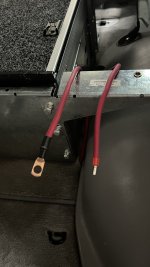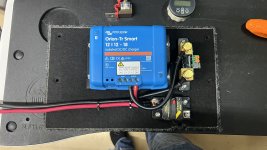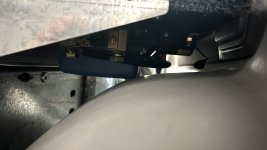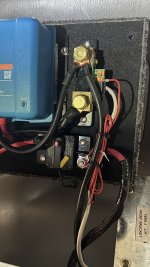RKRUGER
Adventurer- Toyota Nut
I have been running my ARB 50L and other electronics off of an X2 Power 27F for a couple of years now with great results. A 6 awg cable runs from the breaker thru the firewall and terminated at the Blue Sea fuse pack mounted to the face of the ARB drawers. Recently the 27F maintained the fridge full of beer at 42 F while my buddies and I canoed away for 4 days. I set the LVD on HI and the battery still showed 12.4 when we returned. Obviously no one was opening and closing it, and it was full of cold beer, but impressive performance nonetheless.
Recently on Prime Days this battery showed up for $133.
So, I decided to give it a try. It isn’t here yet, so I am not certain the form factor, but at roughly 9x8.5x5 it won’t take up much space in the side wing area of my ARB drawer set.
Today I took a stab at preparing for the battery. And I’d appreciate a set of eyes on the wiring.

6AWG from the start AGM through breaker to the cabin ( this was existing and powered the fridge).

Copper ring terminal is for the house loads and will attach to a Blue Sea 40 amp breaker. Terminated 6 AWG plugs into the Victron DC/DC charger.
Now this is where it gets real.

Neg terminal from Victron and current house loads go to shunt. POS output goes to 40amp breaker and to POS lead to the battery. NEG battery lead goes to shunt. I need to make one more ground wire from the charger and that will go to chassis ground.
I relied heavily on 2022 KISS Dual Battery as well as Travis’s House Battery for inspiration.
Recently on Prime Days this battery showed up for $133.
So, I decided to give it a try. It isn’t here yet, so I am not certain the form factor, but at roughly 9x8.5x5 it won’t take up much space in the side wing area of my ARB drawer set.
Today I took a stab at preparing for the battery. And I’d appreciate a set of eyes on the wiring.

6AWG from the start AGM through breaker to the cabin ( this was existing and powered the fridge).

Copper ring terminal is for the house loads and will attach to a Blue Sea 40 amp breaker. Terminated 6 AWG plugs into the Victron DC/DC charger.
Now this is where it gets real.

Neg terminal from Victron and current house loads go to shunt. POS output goes to 40amp breaker and to POS lead to the battery. NEG battery lead goes to shunt. I need to make one more ground wire from the charger and that will go to chassis ground.
I relied heavily on 2022 KISS Dual Battery as well as Travis’s House Battery for inspiration.
Last edited:



